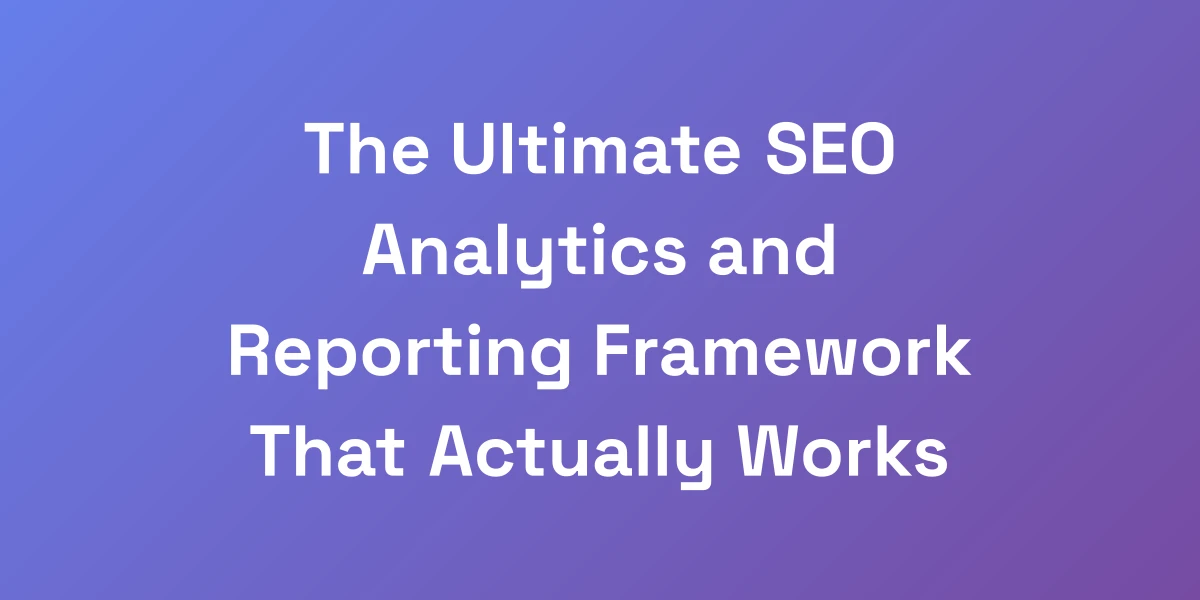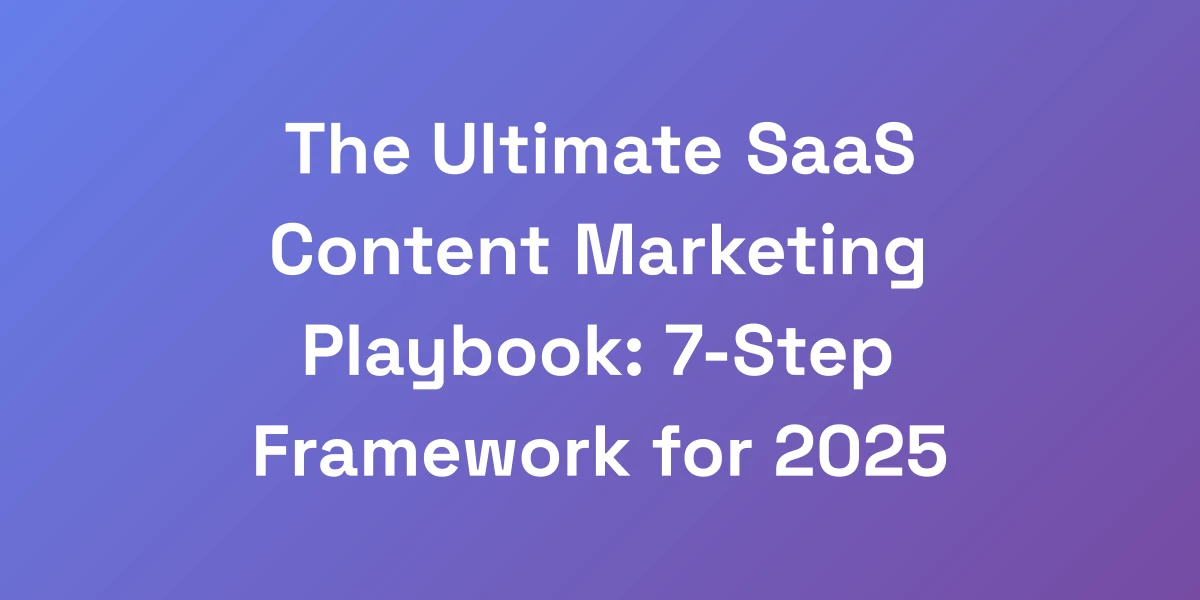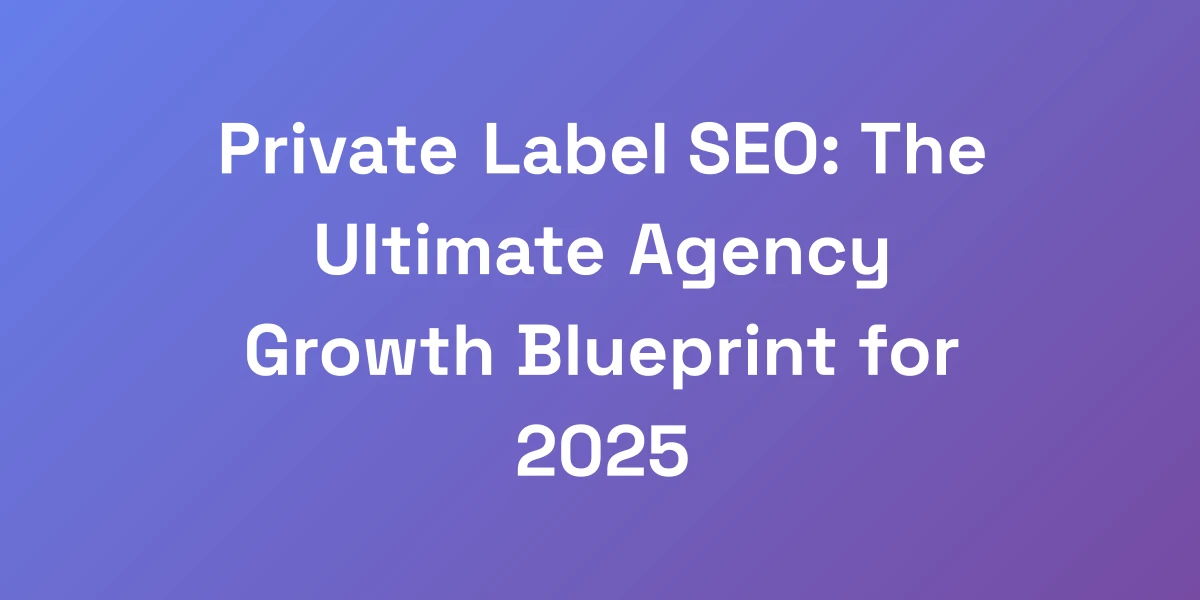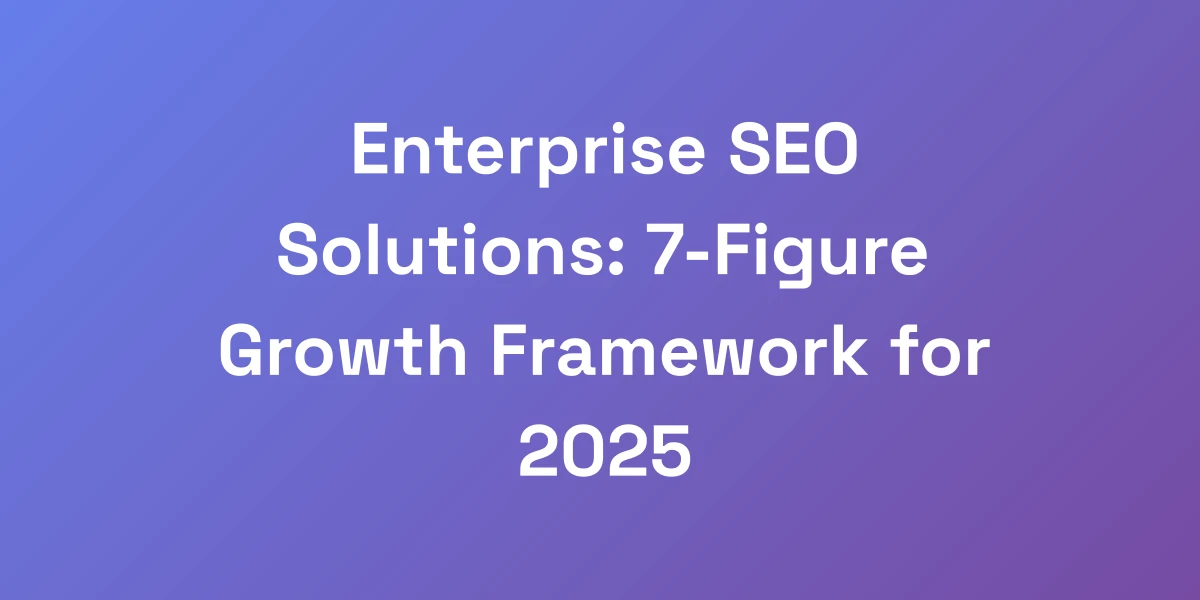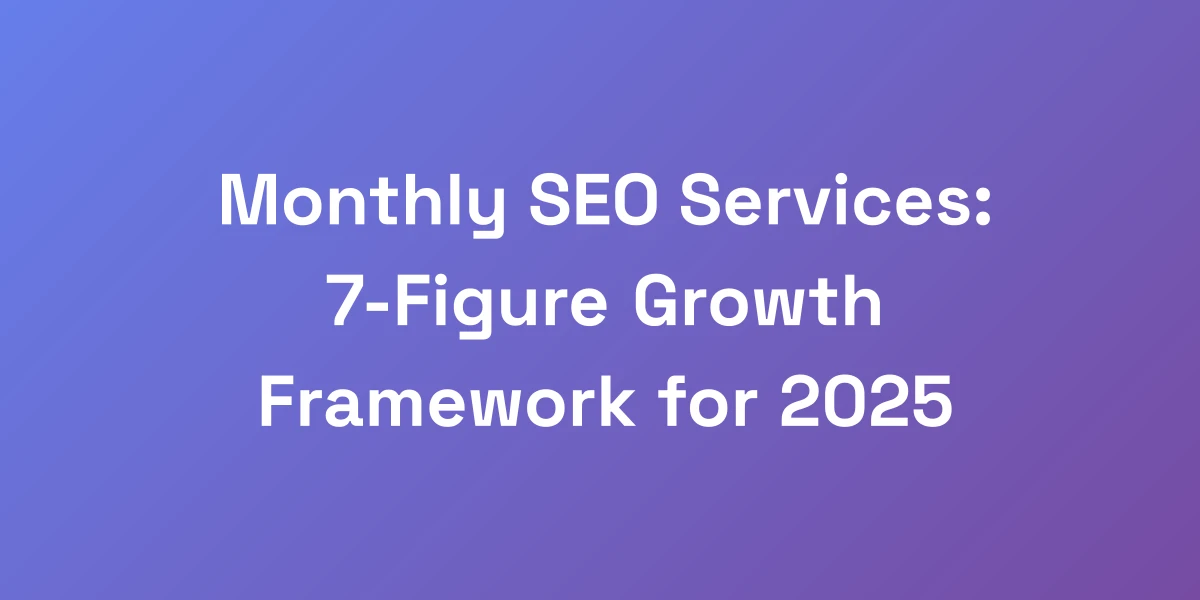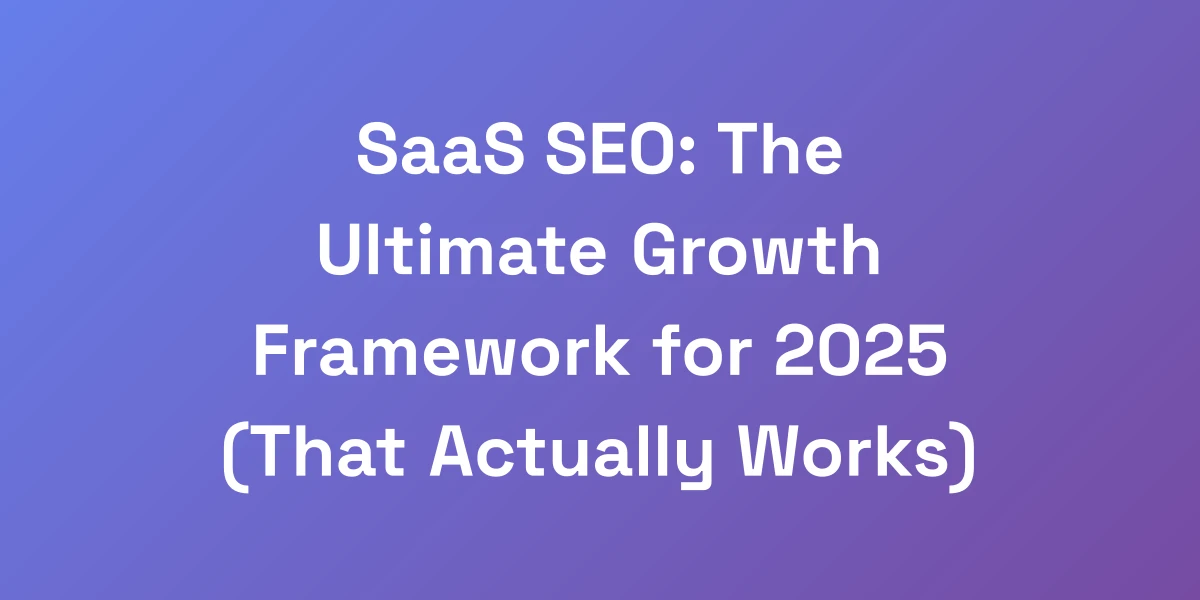
SaaS SEO: The Ultimate Growth Framework for 2025 (That Actually Works)
Mar 12, 2025 | By [email protected]
Introduction
We all know the drill: pouring money into SEO strategies, watching traffic numbers climb, and hoping those visits turn into revenue. But here’s the kicker—for SaaS companies, this approach often falls flat.
Imagine expecting a $20,000 annual commitment from a visitor who’s only interested in a $20 t-shirt. Sounds absurd, right?
Yet, 95% of SaaS companies are burning money on SEO strategies designed for e-commerce. This misalignment isn’t just a minor hiccup—it’s a fundamental flaw that’s stunting your growth.
We’ve scaled multiple 8-figure SaaS companies, navigating the murky waters of SEO to build SEO optimization automation that generate not just traffic, but qualified leads.
Ready to ditch vanity metrics and embrace a framework that drives real growth? Let’s dive into the ultimate SaaS SEO growth framework for 2025.
Why Traditional SEO Fails SaaS Companies (And What to Do Instead)
Let’s hit you with some truth: 95% of SaaS companies are burning money on SEO strategies that were built for e-commerce. Here’s the reality—SaaS customer acquisition is fundamentally different. Your prospects aren’t looking to buy a $20 t-shirt; they’re considering a $20,000 annual commitment.
We’ve helped scale multiple 8-figure SaaS companies, and we’re here to show you exactly how to build an SEO engine that generates qualified leads, not just vanity metrics like “traffic.”
The Unique Challenges of SaaS Customer Acquisition
SaaS companies operate in a different realm than e-commerce businesses. The customer acquisition cost (CAC) for SaaS is significantly higher, averaging around $702, compared to $70 for e-commerce.
Why does this matter? Because the stakes are higher. Every lead counts more, and the pressure to convert is immense. Traditional SEO tactics, designed to drive high volumes of low-cost traffic, simply don’t align with the high-value, low-volume nature of SaaS sales.
For example, targeting generic keywords may attract thousands of visitors, but not all of them are ready to commit to a substantial investment.
Why Traditional SEO Metrics Don’t Tell the Full Story
Metrics like traffic and rankings are just the tip of the iceberg. While these are important, they don’t provide the complete picture for SaaS companies.
Take conversion rates, for instance. A high traffic volume can be misleading if the visitors aren’t converting into paying customers. We need to dig deeper—looking at metrics such as lead quality, user intent, and engagement levels.
Consider a SaaS company that focuses solely on driving traffic. Without measuring how those visitors interact with the content and move through the funnel, you’re essentially flying blind.
The New SaaS SEO Framework for 2025
So, what’s the alternative? A tailored SEO framework that aligns with the unique dynamics of SaaS.
Our framework focuses on:
- Qualifying Leads: Ensuring that the traffic you attract is composed of potential customers ready to make high-value commitments.
- User Intent Alignment: Creating content that matches the specific needs and questions of your prospects at different stages of their journey.
- Strategic Content Placement: Positioning content where it can effectively nurture leads from awareness to decision-making.
By implementing this framework, you can transform your SEO efforts from wasteful to powerhouse, driving sustainable growth.
Case Study: How We 10x’d MRR Through SEO
Let’s talk numbers. One of our portfolio companies was struggling with stagnant MRR despite increasing traffic.
We revamped their SEO strategy, focusing on high-intent keywords and optimizing their content for conversion. Within six months, their MRR 10x’d.
How? By targeting keywords that aligned with their product features and customer pain points, we attracted visitors who were genuinely interested in their solution. Coupled with optimized landing pages and clear CTAs, the traffic turned into paying customers.
This isn’t just a fluke. It’s a testament to what a well-structured SaaS SEO strategy can achieve.
Building Your SaaS Content Moat
Here’s what nobody tells you about SaaS SEO: Content velocity without strategic intent is just expensive noise.
We’re going to show you how to build what I call a “Content Moat”—a systematic approach to creating content that not only ranks but converts. The key is understanding the three layers of SaaS content: top-of-funnel awareness, middle-funnel consideration, and bottom-funnel conversion.
The Three-Layer Content Strategy for SaaS
Each layer serves a specific purpose in your growth engine, creating a comprehensive content ecosystem.
- Top-of-Funnel (Awareness): Content that educates and attracts a broad audience.
- Middle-Funnel (Consideration): Content that engages and nurtures interested prospects.
- Bottom-Funnel (Conversion): Content designed to convert leads into paying customers.
By strategically creating content for each stage, you ensure a seamless journey from discovery to decision.
Creating High-Converting Product-Led Content
Your content should do more than inform—it should guide prospects toward taking action.
For instance, product-led content involves detailed guides, tutorials, and use cases that showcase your product’s value. When done correctly, this type of content not only ranks well but also builds trust and authority.
For example, a SaaS company offering project management software might create comprehensive guides on improving team collaboration, integrating their tool into existing workflows, and case studies demonstrating successful implementations.
These resources not only attract traffic but also position the company as a thought leader, making prospects more likely to choose their solution.
Competitive Content Gap Analysis
Understanding where your competitors are lacking is a goldmine for opportunities.
Conduct a thorough content gap analysis to identify topics your competitors haven’t covered or haven’t covered well. For instance, if a competitor focuses solely on product features, you can differentiate by providing in-depth industry insights and problem-solving content.
Here’s how:
- Identify competitor top-performing content using tools like Ahrefs or SEMrush.
- Analyze the depth and quality of their content.
- Identify underserved topics or angles.
- Create superior content that fills these gaps, providing more value and insights.
This approach not only helps you rank higher but also attracts a more engaged and interested audience.
Content Distribution Frameworks
Creating great content is only half the battle. You need an effective distribution strategy to ensure it reaches the right audience.
Utilize multiple channels to amplify your content’s reach:
- Social Media: Share content across platforms where your audience is active.
- Email Marketing: Use newsletters to distribute content directly to subscribers.
- Content Syndication: Partner with industry publications to reach a wider audience.
- SEO Optimization: Ensure all content is optimized for search engines to drive organic traffic.
By leveraging these channels, you maximize the visibility and impact of your content moat.
Measuring Content ROI Beyond Rankings
Rankings are important, but they don’t tell the whole story. To truly measure the ROI of your content, track metrics that align with your business goals.
Focus on:
- Lead Generation: How many leads are your content pieces generating?
- Conversion Rates: Are these leads converting into paying customers?
- Engagement Metrics: Are visitors interacting with your content and spending time on your site?
- Customer Lifetime Value: Are the leads generated through your content contributing to long-term revenue?
By tracking these metrics, you can refine your content strategy to focus on what truly drives growth.
Technical SEO Optimization for SaaS Platforms
Listen, we’ve audited over 100 SaaS websites, and the same technical issues keep killing their conversion rates. Your fancy JavaScript framework might look cool, but if Google can’t crawl it properly, you’re dead in the water.
We’re about to break down the exact technical optimization playbook we use for our portfolio companies that generate $100M+ in ARR.
JavaScript SEO for Modern SaaS Applications
Modern SaaS applications often rely heavily on JavaScript frameworks like React, Vue, or Angular. But without proper optimization, search engines can struggle to index your content.
Key strategies include:
- Server-Side Rendering (SSR): Ensures that content is pre-rendered, making it easier for search engines to crawl and index.
- Dynamic Rendering: Provides search engines with static content while maintaining interactive experiences for users.
- Code Splitting and Lazy Loading: Improves site speed by loading only necessary components.
Implementing SSR or dynamic rendering can drastically improve your SEO performance, ensuring that your content is both accessible and engaging.
Site Architecture for Product-Led Growth
A well-structured site architecture not only enhances user experience but also boosts SEO. For SaaS platforms, this means:
- Clear Navigation: Ensure users can easily find key sections like product features, pricing, and support.
- Logical Hierarchy: Organize content in a way that reflects the user journey, from awareness to conversion.
- Internal Linking: Use strategic internal links to guide users and distribute link equity effectively.
A streamlined architecture supports both user experience and search engine crawling, laying the foundation for effective SEO.
Mobile Optimization Strategies
With 58.67% of global web traffic coming from mobile devices, mobile optimization isn’t just an option—it’s a necessity.
Key strategies include:
- Responsive Design: Ensure your site adapts seamlessly to different screen sizes.
- Fast Load Times: Optimize images, leverage browser caching, and minimize JavaScript to reduce load times.
- Mobile-Friendly Navigation: Simplify menus and ensure buttons are easily tappable.
A mobile-first approach not only enhances user experience but also improves your rankings, as Google prioritizes mobile-friendly sites.
Core Web Vitals Optimization
Core Web Vitals—page speed, mobile usability, and interactivity—are critical for SEO and user experience. Recent benchmarks show that websites passing the Core Web Vitals assessment saw a significant upsurge in user engagement.
Optimize your Core Web Vitals by:
- Improving Load Times: Aim for a page load time of under 2 seconds.
- Enhancing Interactivity: Ensure quick response times to user interactions.
- Stabilizing Layouts: Prevent unexpected content shifts that frustrate users.
Tools like Google Search Console, PageSpeed Insights, and Lighthouse are invaluable for monitoring and improving these metrics.
International SEO for Global SaaS
If your SaaS targets a global audience, international SEO is a game-changer. This involves optimizing your site for multiple languages and regions.
- Hreflang Tags: Use these to indicate the language and regional targeting of your pages.
- Localized Content: Tailor your content to resonate with different cultural contexts.
- Geo-Targeting: Optimize content and keywords based on regional search behaviors.
By effectively managing international SEO, you can tap into new markets and drive growth on a global scale.
Building Authority Through Strategic Link Building
Stop begging for backlinks like it’s 2010. In the SaaS space, authority is built through strategic partnerships and content amplification.
We’re going to show you our exact outreach templates that get a 70% response rate, and how we’ve built link profiles that crush competitors without spending a dime on sketchy link building services.
Industry-Specific Link Building Tactics
Generic link building tactics rarely work for SaaS companies. Instead, focus on industry-specific strategies:
- Guest Blogging: Contribute to authoritative industry blogs to earn quality backlinks.
- Resource Pages: Get your content listed on industry resource pages and directories.
- Collaborative Content: Partner with other industry leaders for co-authored content that naturally attracts links.
These targeted approaches ensure that your backlinks are relevant and authoritative, boosting your site’s credibility.
Strategic Partnership Development
Building strategic partnerships is a powerful way to earn high-quality backlinks and expand your reach.
Steps to develop strategic partnerships:
- Identify Potential Partners: Look for companies and influencers in your niche with similar audiences.
- Offer Mutual Value: Create win-win scenarios where both parties benefit from the partnership.
- Collaborate on Content: Develop joint content projects like webinars, eBooks, or case studies that can be shared and linked to by both partners.
These partnerships not only enhance your link profile but also position your brand as an industry leader.
Content Amplification Networks
Amplifying your content ensures it reaches a larger audience, increasing the chances of earning backlinks.
Utilize various networks to distribute your content:
- Social Media Platforms: Share your content across LinkedIn, Twitter, and niche forums.
- Email Newsletters: Feature your content in your email campaigns to drive traffic and shares.
- Content Syndication: Partner with platforms that can republish your content to reach new audiences.
By strategically amplifying your content, you increase its visibility and the likelihood of earning valuable backlinks.
Authority Building Through Thought Leadership
Establishing thought leadership is key to building authority. Create and share insights that demonstrate your expertise and foresight in the SaaS industry.
How to build authority through thought leadership:
- Publish Original Research: Share data-driven insights and reports that provide value to your audience.
- Host Webinars and Workshops: Conduct educational sessions that showcase your knowledge.
- Speak at Industry Events: Gain visibility by presenting at conferences and seminars.
These activities not only enhance your reputation but also naturally attract authoritative backlinks.
Measuring Link Quality and Impact
Not all backlinks are created equal. Measuring the quality and impact of your links ensures your efforts are effective.
Key metrics to assess link quality:
- Domain Authority: Higher authority sites provide more value.
- Relevance: Links from sites related to your niche are more beneficial.
- Traffic: Backlinks from high-traffic sites can drive additional referrals.
- Anchor Text: Relevant anchor text improves keyword targeting.
Regularly audit your backlink profile to identify and focus on high-quality links that contribute to your SEO goals.
Converting SEO Traffic Into Paying Customers
Here’s the brutal truth: traffic without conversion is just expensive hosting.
We’re going to show you how we’ve built conversion frameworks that turn organic traffic into qualified demos and trials. The secret isn’t in the traffic—it’s in understanding user intent and building content experiences that match it perfectly.
Intent-Based Landing Page Optimization
Align your landing pages with the specific intents of your visitors.
- Informational Intent: Provide in-depth guides and resources.
- Transactional Intent: Showcase product features and benefits with clear CTAs.
- Navigational Intent: Ensure easy access to key sections like pricing and support.
By tailoring your landing pages to match user intent, you create a more seamless and persuasive path to conversion.
CTA Strategy for Different Funnel Stages
Your Call-to-Actions (CTAs) should vary based on where the visitor is in the funnel.
- Top-of-Funnel: CTAs encouraging content downloads or newsletter sign-ups.
- Middle-Funnel: CTAs for demo requests, webinars, or case studies.
- Bottom-Funnel: CTAs for free trials, consultations, or purchases.
Strategically placing tailored CTAs increases the likelihood of guiding users to the next stage of their journey.
A/B Testing Framework for SaaS Pages
Continuous optimization is key. Implement an A/B testing framework to identify what works best.
- Identify Variables: Test different headlines, CTAs, layouts, and images.
- Set Clear Goals: Define what success looks like—be it increased conversions or engagement.
- Analyze Results: Use data to inform your decisions and iterate accordingly.
Regular A/B testing helps you refine your pages for maximum conversion efficiency.
Lead Qualification Through Content
Not every visitor is a potential customer. Use content to qualify leads effectively.
- Educational Content: Attract visitors who are in the research phase.
- Product-Focused Content: Engage leads who are evaluating solutions.
- Transactional Content: Convert ready-to-buy visitors into customers.
By aligning content with lead stages, you ensure that your efforts are focused on nurturing high-quality prospects.
Attribution Modeling for SEO
Understanding how different touchpoints contribute to conversions is crucial for optimizing your SEO strategy.
- First-Touch Attribution: Credits the initial interaction.
- Last-Touch Attribution: Credits the final interaction before conversion.
- Multi-Touch Attribution: Distributes credit across multiple interactions.
Implementing a robust attribution model helps you identify which SEO efforts are driving the most value, allowing you to allocate resources more effectively.
Conclusion
We’ve laid out the framework—the steps, strategies, and insights needed to transform your SaaS SEO efforts into a powerhouse of growth. Traditional SEO tactics won’t cut it for SaaS, but with our tailored approach, you can overcome the unique challenges of SaaS customer acquisition.
From building a robust content moat and optimizing your technical SEO to strategically building authority and converting traffic into paying customers, every aspect of this framework is designed to drive real, measurable growth.
Ready to take your SaaS SEO strategy to the next level? Start implementing these strategies today, and watch your growth numbers soar in 2025 and beyond.
What’s your biggest SEO challenge? Drop a comment below or reach out to us to discuss how we can help you achieve your growth goals.
For those interested in expanding their content capabilities, explore our insights on AI-powered autoblogging to streamline your content creation process.
Agencies looking to enhance their efficiency can leverage our marketing automation strategies designed specifically for modern agencies.
Additionally, utilizing automated SEO tools can significantly boost your SEO rankings by optimizing various aspects of your website effortlessly.
Finally, small businesses aiming to compete in the SaaS space should consider our content marketing strategies for small businesses to drive growth and maximize ROI.
